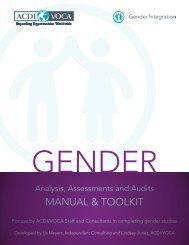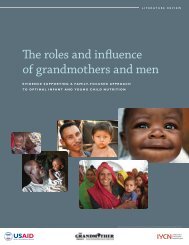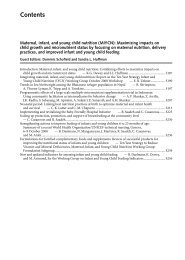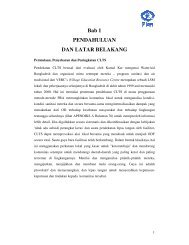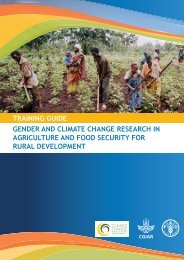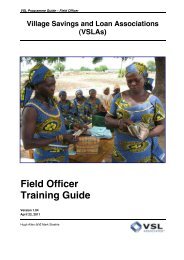Module 2. Theorethical Concepts of Gender - FSN Network Portal
Module 2. Theorethical Concepts of Gender - FSN Network Portal
Module 2. Theorethical Concepts of Gender - FSN Network Portal
Create successful ePaper yourself
Turn your PDF publications into a flip-book with our unique Google optimized e-Paper software.
Mainstreaming <strong>Gender</strong> into Water, Sanitation and Hygiene (WASH) Programs<br />
<strong>Module</strong> 2: Theoretical <strong>Concepts</strong> <strong>of</strong> <strong>Gender</strong><br />
Lesson 9: Different Approaches to <strong>Gender</strong> and Development: a Historical Understanding<br />
Handout 9.1<br />
Definitions <strong>of</strong> Terms relating to Transition from<br />
Women in Development to <strong>Gender</strong> and Development<br />
Initially, international development operated within a patriarchal paradigm and<br />
was designed by men, predominantly for the benefit <strong>of</strong> men. In relation to how<br />
development affects women, there has been a transition from Women in<br />
Development (WID) to <strong>Gender</strong> and Development (GAD). The terms WID and<br />
GAD are sometimes used interchangeably, but there are some important<br />
differences. Both approaches are still in use and are applicable in different<br />
situations.<br />
Women in Development (WID)<br />
The WID approach emerged in the 1970s, with the objective <strong>of</strong> designing<br />
actions and policies to integrate women fully into development. It began with<br />
an uncritical acceptance <strong>of</strong> existing social structures and focused on how<br />
women could be better integrated into existing development initiatives. It<br />
included strategies such as women-only projects, focusing on training, and<br />
women’s productive work – <strong>of</strong>ten credit and income-generation projects.<br />
The early WID approach tended to support women-targeted activities that<br />
were token in scale and impact, and marginal to the development<br />
mainstream. WID treated women as passive recipients <strong>of</strong> development.<br />
Women’s concerns were viewed in isolation as separate issues. WID failed to<br />
address the systematic causes <strong>of</strong> gender inequality. Critics <strong>of</strong> modernisation<br />
theories and the WID approach maintained that women have always been<br />
part <strong>of</strong> the development process, and that integrating women into<br />
development is therefore a myth.<br />
<strong>Gender</strong> and Development (GAD)<br />
The GAD approach was developed in the 1980s. Its objective was to remove<br />
disparities in social, economic and political equality between women and men<br />
as a pre-condition for achieving people-centred development. It was a<br />
response to the perceived failure <strong>of</strong> WID. Instead <strong>of</strong> focusing only on women,<br />
GAD is concerned with the relations between men and women and<br />
challenges unequal decision-making and power relations. GAD seeks to<br />
address the underlying causes <strong>of</strong> gender inequality. It does this by<br />
considering the different life experiences <strong>of</strong> women and men, redistributing<br />
power, mainstreaming gender into planning at all levels and in all sectors, and<br />
focusing on the steps necessary to ensure equal outcomes.<br />
This gender mainstreaming approach brought three new dimensions to the<br />
debate on women and development:<br />
• a strong comparative perspective that challenged the assumption <strong>of</strong><br />
men and the male situation as the norm;<br />
• an explicit objective <strong>of</strong> integrating women’s concerns and priorities into<br />
mainstream decision making;<br />
A Training Manual for Water Pr<strong>of</strong>essionals developed collaboratively by PROTOS and SNV, 01/02/2007<br />
<strong>2.</strong>57



